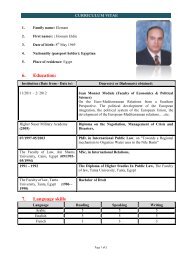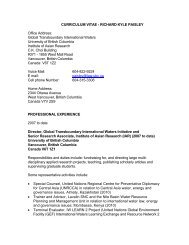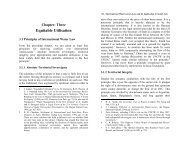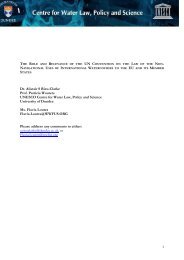Upreti, Trilochan, International Watercourses Law and Its Application ...
Upreti, Trilochan, International Watercourses Law and Its Application ...
Upreti, Trilochan, International Watercourses Law and Its Application ...
You also want an ePaper? Increase the reach of your titles
YUMPU automatically turns print PDFs into web optimized ePapers that Google loves.
212 / <strong>International</strong> <strong>Watercourses</strong> <strong>Law</strong> <strong>and</strong> <strong>Its</strong> <strong>Application</strong> in South Asia Prospects <strong>and</strong> Problems of Nepalese Water Resources / 213It is clearly envisaged in the Ninth (1997-2002) as well as theTenth Plan (2003-2008) that both poverty eradication <strong>and</strong>infrastructure development will be accomplished by means ofthe effective <strong>and</strong> efficient utilisation of water resources.Furthermore, bilateral <strong>and</strong> regional co-operation will beenhanced in order to achieve these goals; small <strong>and</strong> mediumhydroelectric projects should be carried out to meet domesticneeds, whereas mega-projects will be undertaken to exportpower to the neighbouring countries with other downstreambenefits being shared. 98 The Nepalese government adoptedpolicies <strong>and</strong> made laws in this context, 99 <strong>and</strong> also adopted awater resources strategy recently. 100 The strategy sets out indetail the proposed use of these resources for povertyalleviation <strong>and</strong> infrastructure development, by exportinghydroelectricity from the mega projects, alongside domesticconsumption from medium <strong>and</strong> small projects, <strong>and</strong>implementation of these resources in the spirit of bilateral aswell as regional co-operation. 101Under the existing arrangement between India <strong>and</strong> Nepal, up to100 MW of electric power may be traded (in either direction)between the two countries according to requirements. Nepal iswilling to increase this figure to 150 MW, by including power98 His Majesty's Government, Nepal , The Ninth Plan, Kathm<strong>and</strong>u, 1998,pp. 89-92; also see N. K. Sharma, Planning <strong>and</strong> Development in Nepal<strong>and</strong> the Tenth Plan, Kathm<strong>and</strong>u: Pairibi Pub., (Nepali version), 2003,p. 119.99 Hydropower Development Policy (2049), Irrigation Policy (2060),Industrial Policy (2049), Foreign Investment <strong>and</strong> One Window Policy,(2049), Establishment of Power Development Fund from the WorldBank /HMG joint Fund, membership of MIGA <strong>and</strong> New YorkConvention on Foreign Arbitration Award 1958.100 Supra note 2, p. 36.101 Ibid. p. 115: from private sector involvement, the Khimti (60 MW) <strong>and</strong>the Bhotekosi (36 MW) projects were implemented; similarly,Indrawati (5 MW) has been developed <strong>and</strong> also west Seti (750 MW),which is an export oriented project, has been in the implementationstage.generated from the Kali G<strong>and</strong>aki A project. 102 However, themajor obstacle to Nepal’s export potential is the noncooperativeattitude of the buyer 103 <strong>and</strong> the expense of electricitygeneration. 104 If it cannot be harnessed at a competitive price,the chances of export are nil. Private sector involvement maybe required in order to achieve efficiency <strong>and</strong> competitivetargets. 105 In the Nepalese context, the Independent PowerProducers (IPP) are generating around 100 MW of electricity<strong>and</strong> the NEA, a governmental entity, has an expensive PowerPurchase Agreement (PPA), about 7 US Cents/kWh; such anexorbitant price would make it unable to use or export power.Even Pakistan has paid the IPPs 6.5 US cents/kWh <strong>and</strong> is notable to export to India at the same price. Therefore, the pricingpolicy needs to be reviewed. 106In the existing Nepalese energy situation, only 1% of totalenergy consumption comes from hydro-electric source, 68%from wood fuel, 15% from agricultural residues, 8% fromimported petroleum products <strong>and</strong> 8% from cow dung <strong>and</strong> coal.Under these circumstances, in order to mitigate the adverse102 The MD of NEA set forth his plan of exporting 150 MW ofhydropower to India; Staff, “NEA exporting electricity to India”, TheKathm<strong>and</strong>u Post, 16 August 2002; also see A. B. Thapa, “UncertainFuture” in 22 Spotlight, 14-20 March (2003).103 “Nepal-India Power Trade”: while Nepal negotiated to sell her extraelectricity after the completion of the Kalig<strong>and</strong>aki A project, Indiaoffered Rs 2.50 per unit, which is far below the generation price <strong>and</strong>also below the market rate in India. 22 Spotlight, March 21-27, (2003).104 Supra note 25, p. 179: the cost per KW of installing mini-hydro plantsvaries from a low of around US $ 350 in Pakistan to a high of US $2,000 in Nepal; also see D. Gywali, “Himalayan Waters: BetweenEuphoric Dreams <strong>and</strong> Ground Realities” in K. Bahadur & M. P. Lama(eds), Nepal Perspectives on Indo-Nepal Relations, New Delhi: Har-An<strong>and</strong> Pub., 1995, p. 253; due to the international consultant <strong>and</strong>contractor investment, Nepalese hydropower generation is four to fivetimes more expensive on a per KW basis than it is in India or Bhutan.105 Ibid.106 S. B. Pun, “The Evolving Role of the Public <strong>and</strong> Private Institutions inthe Nepalese Power Sector” in Annual Report of Water <strong>and</strong> EnergyCommission Secretariat, (1999) pp 38-49.












